Gretsch Night in NYC!
Few musical instrument companies can boast of celebrating 140 years in business. Likewise, few musical instrument companies can boast of still being family-owned after so many years. But only one drum company can lay claim to both. That company is Gretsch. Founded in Brooklyn in 1883, the company “came home” to New York City’s Cutting Room this past May 23rd to celebrate its 140th anniversary.
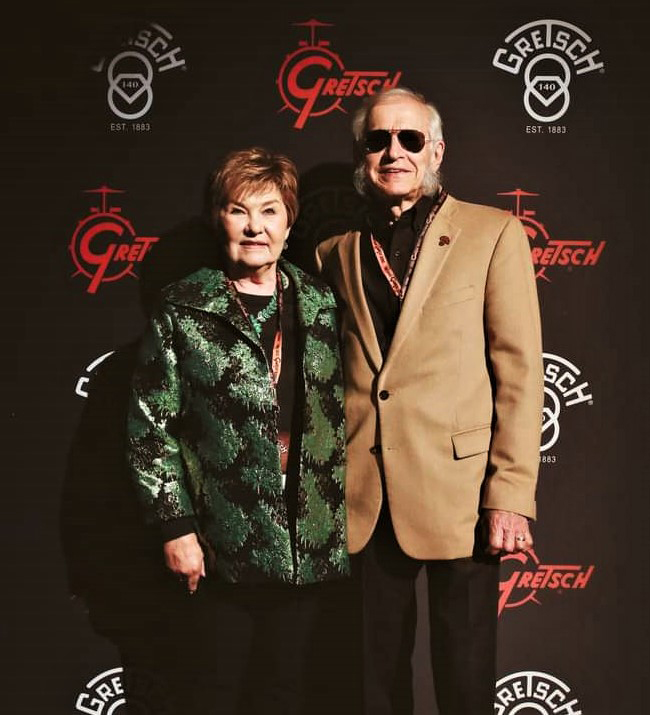
The Cutting Room has itself been a landmark on New York City’s music scene since 1999. The goal of its founders was to offer “a fresh new take on what a rock club and lounge should feel like, with extraordinary performances and special moments.” Gretsch Night In NYC indisputably offered both.
A FAMILY AFFAIR
The evening opened with greetings from Fred and Dinah Gretsch, representing the fourth generation of Gretsch Family leadership. Also in attendance were daughter Lena Thomas (fifth generation) and grandchildren Logan Thomas and Chelsea Roller (sixth generation).
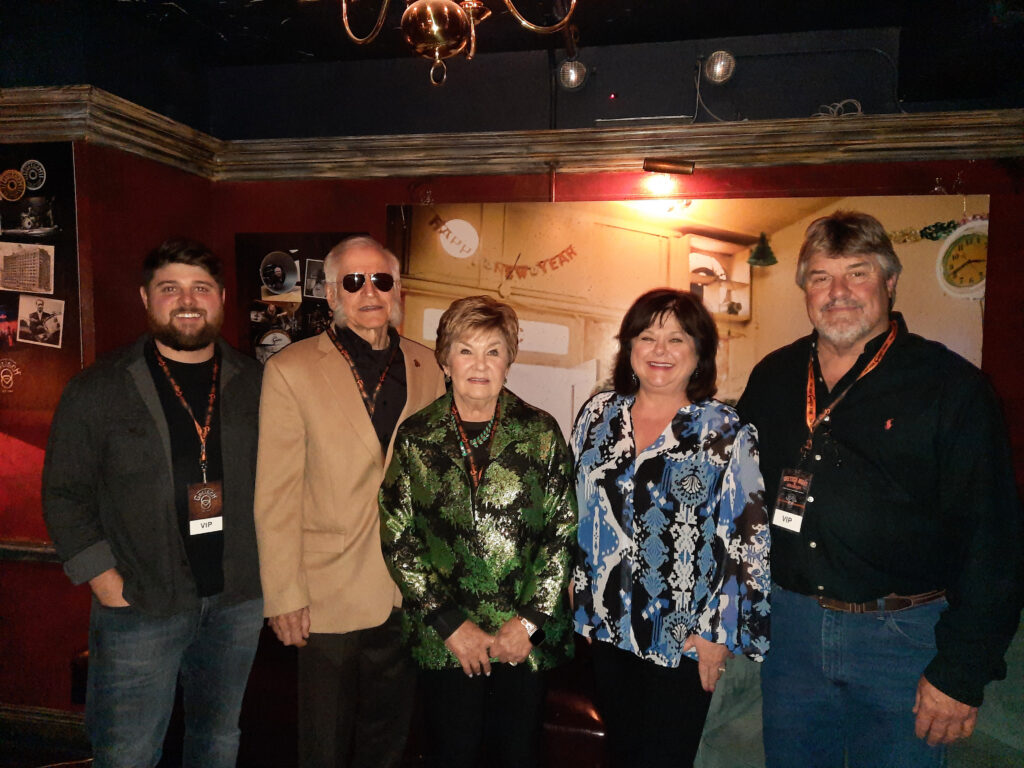
The Gretsch Family (from left): Logan Thomas, Fred Gretsch, Dinah Gretsch, Lena Thomas, and Lena’s fiancé Robbie Bunton.
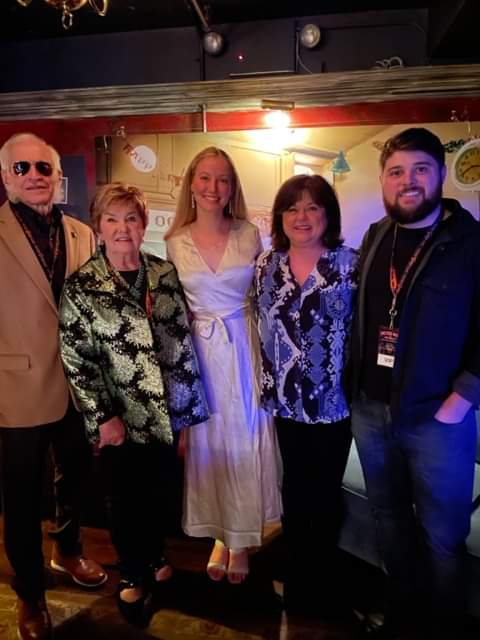
The Gretsch Family including sixth generation granddaughter Chelsea Roller.
A SPECIAL SPECIAL OCCASION
As if the Gretsch Company’s 140th anniversary wasn’t enough, there was another special occasion to celebrate on Gretsch Night In NYC: Dinah Gretsch’s birthday! In addition to well wishes from the many friends and family who joined the iconic lady on this auspicious evening, Dinah was also presented with a bass drum head signed by all of the performing artists, participating industry notables, and other individuals offering their best wishes.
ONE UNIQUE ATTENDEE
Gretsch Night in NYC took place on May 23, 2023. And although it stands as historic in its own right, it shares a bit of history with another remarkable event. On April 25 and 26, 1960, the iconic “Gretsch Night At Birdland” took place. The album that resulted from these two evenings has become legendary within the drum community. The great Gretsch drummers who appeared on those nights were Art Blakey, Charlie Persip, Elvin Jones, and “Philly” Joe Jones. Not surprisingly, all of these jazz giants are among the influences cited by the drummers who appeared—sixty-two years and one month later, almost to the day—at Gretsch Night In NYC.
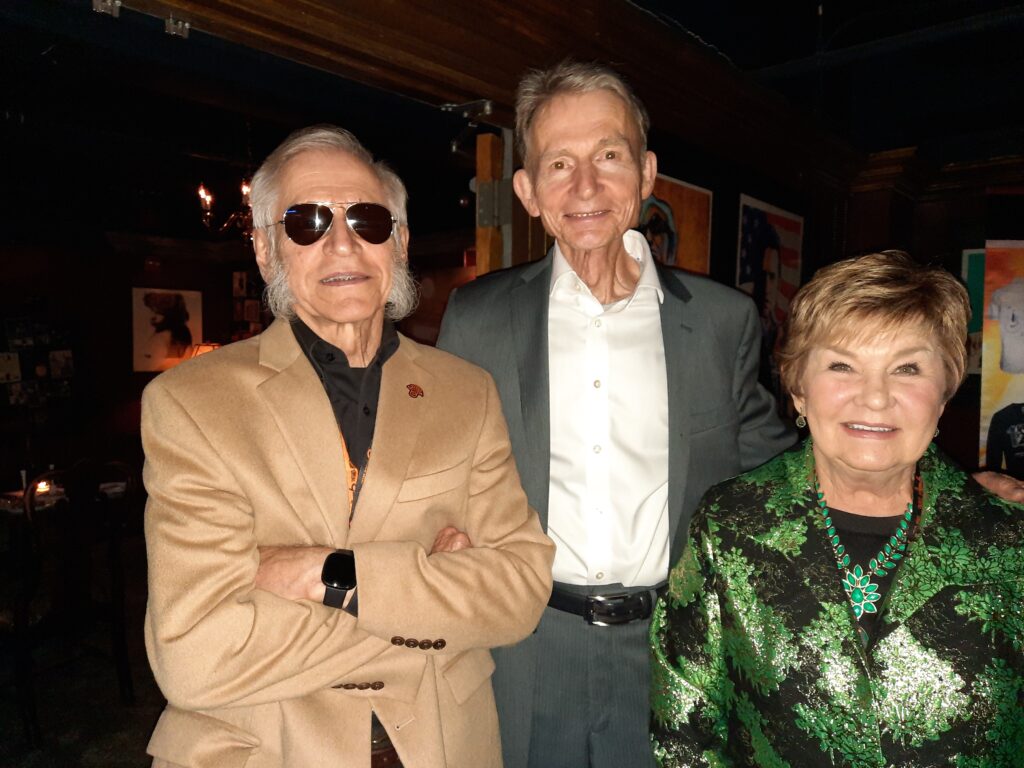
Web Grant with Fred and Dinah.
In an amazing turn of events, one individual attended both of these historic occasions. Web Grant was thirteen when his father, Phil Grant, brought him and his twin brother Jim to the Birdland show in 1960. Web was an aspiring jazz drummer at the time, and his father was the long-time VP, product manager, and artist relations manager for Gretsch drums. From the late 1950s through the early ’60s, Phil Grant was instrumental in aligning Gretsch with Birdland, and it was he who first posed the idea of a “drum night.” As Web recalls of the evening’s performances, “I was just awestruck, being in the presence of these giants. All four of them were great players, and I got to meet all of them!”
And so it was entirely appropriate that Web Grant return to New York City to attend Gretsch Night In NYC, enjoy the performances of four great contemporary players, and meet all of them. Says Web, “I want to express my gratitude to Fred and Dinah for inviting me. This event means a lot to me, being here representing my father, who gave so much to the Gretsch Company. And to hear all these great drummers is really a personal joy for me.”
OTHER VISITORS
A number of drum industry notables were among the attendees at the evening’s festivities. These included Paul Cooper, who heads up production for Gretsch Drums, along with production manager Josh Safer; Yoshitaka Shibata of Roland Corporation; Tim Shahady of Paiste Cymbals; and Neil LaFortune, who conducts the Gretsch Afternoon Drum Break interview series.
Also at the show was John Sheridan. John is a drum historian, a Gretsch super-fan and collector, and the co-author (with Rob Cook) of The Gretsch Drum Book—which is the authoritative source of information for all things relating to Gretsch drums.
Not one, but two former editors of Modern Drummer magazine were on hand as well. Former editor-at-large Billy Amendola now conducts interviews for Drum Channel, a popular streaming online educational platform. Former senior editor Rick Van Horn is now the touring drummer for 1960s singing icons Jay & The Americans, and also serves as publicist for Fred and Dinah Gretsch and the Gretsch Family.
A DOCUMENTARY PREMIER
Before the live performances began, the audience was treated to the premier of a new documentary entitled Round Badge Stories. It was enthusiastically introduced by Gretsch Drums product and artist relations manager Andrew Shreve, who served as emcee for the evening’s festivities.
The 41-minute film—narrated by no less a drum star than Vinnie Colaiuta—featured historic information about Gretsch drums, along with commentary from dozens of top Gretsch artists including Cindy Blackman-Santana (Santana Band), Steve Ferrone (Eric Clapton, Tom Petty), Keith Carlock (Steely Dan), Stanton Moore (Galactic), Matt Sorum (Velvet Revolver, Kings Of Chaos), Jason McGerr (Death Cab For Cutie) and many others—as well as from notable recording engineers and drum retailers. That commentary ranged from the construction of Gretsch drums and their unique historic consistency, to the near-fanatical community spirit among Gretsch drummers, and the fact that even drummers associated with other brands “all have a Gretsch kit at home.”
Watch now!
THE PERFORMANCES
Of course, the highlight of the evening was the performances by four stellar Gretsch artists. The audience was teased about these beforehand, by the sight of a beautiful 140th Anniversary drumkit that was placed center-stage to be a focal point as soon as the doors opened.
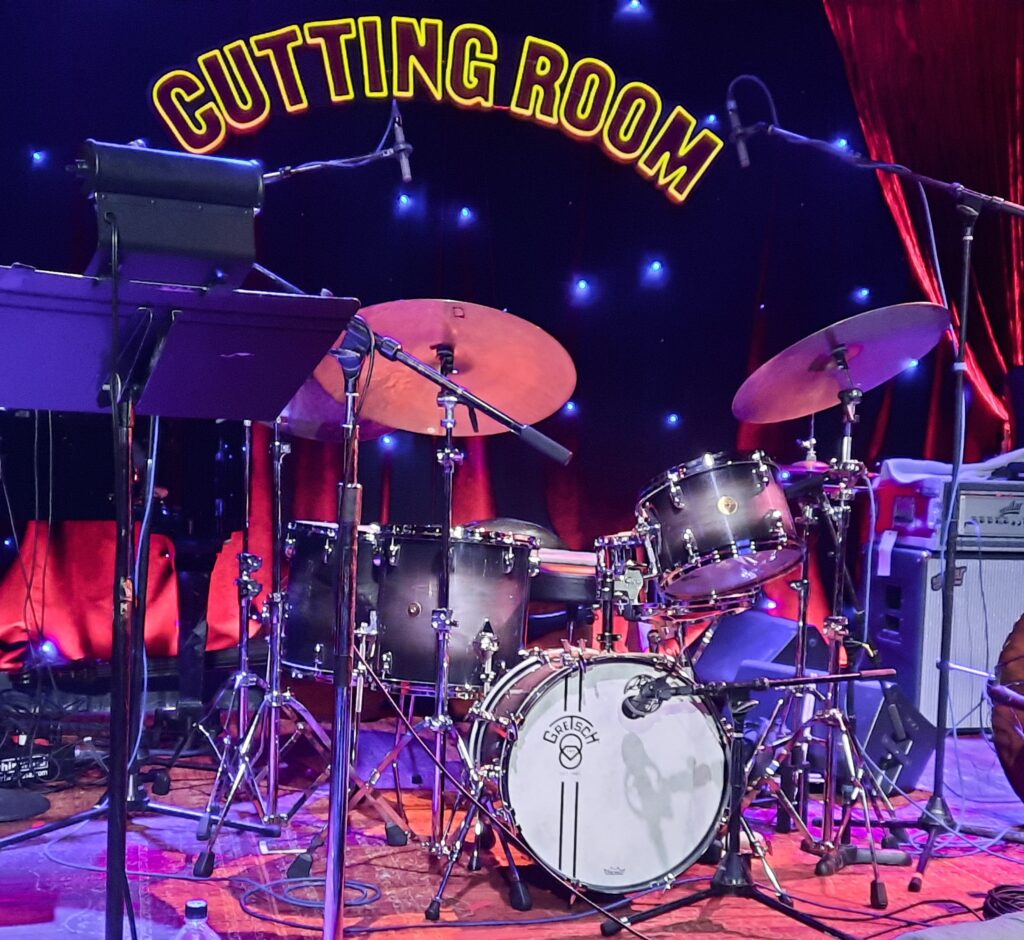
140th Anniversary Kit.
BILL STEWART
Finally, the musical portion of the show got started with a performance by Bill Stewart. Unquestionably a key figure on the contemporary jazz scene, Bill has performed with John Scofield, Pat Metheny, Maceo Parker, Joe Lovano, and a host of jazz luminaries. He has also recorded many CDs of his own, and is the co-leader of a long-standing trio with Larry Goldings and Peter Bernstein, whose album “Perpetual Pendulum” was released last year.
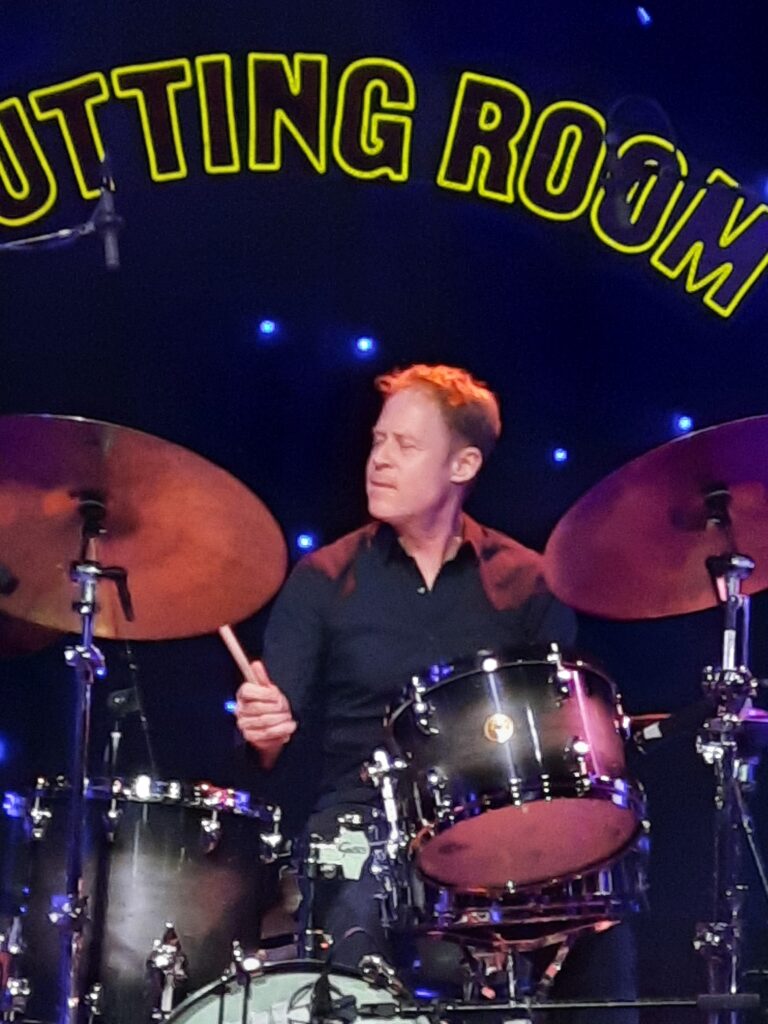
Bill Stewart
Turning to Bill’s appearance at Gretsch Night In NYC, he played in a unique trio format that featured an acoustic bassist and a saxophonist. The two extended numbers that the group played allowed for extensive sonic exploration within a very “open” format. Rhythmic structure was extremely fluid, and Bill took advantage of this to vary his playing between being supportive of the other players and taking charge in dynamic solo spots. The audience was captivated throughout, as was made evident by the rousing ovation they gave to Bill and his bandmates at the conclusion of their set.
In an interview prior to the Drum Night In NYC event, Bill was asked how he became a Gretsch artist. He replied, “I started playing around New York in the late ’80s. I played a lot of other people’s Gretsch drums, on gigs and in studios. I loved the sound of them. When I could finally afford a Gretsch kit, I bought one in 1990. I played those drums for ten years before I got an endorsement in 2000.”
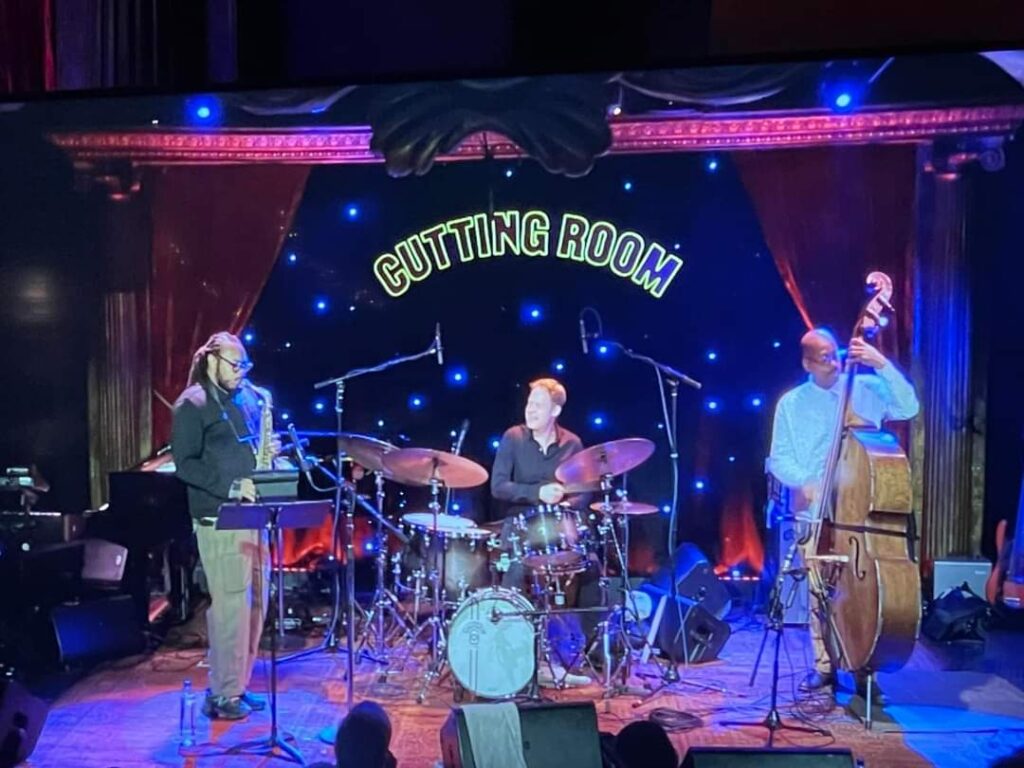
Bill Stewart Trio
And how did that endorsement come about? “I got a call out of the blue from Dinah Gretsch,” Bill responds, “saying that she’d be interested in speaking to me about becoming an endorser. By that time my career was pretty well established, and I was already playing Gretsch drums. So why not? When I first signed on, Fred and Dinah invited me down to the factory. They were very kind and generous. They had two of the same drumsets made, and invited me to pick my choice of drum from each one. That’s how I got my own kit.
“I think it’s great that the family has maintained the quality of the drums and the sound of Gretsch,” Bill continues. “We’ve all heard the great Gretsch players, like Tony Williams and Elvin Jones, just to name two of the most famous. That same sound…I hear it now in Gretsch drums, and I’m very glad that Gretsch has been able to maintain that.”
Gretsch Night In NYC takes place sixty-two years after the famous Gretsch Night At Birdland. That show featured Art Blakey, Elvin Jones, Philly Joe Jones, and Charlie Persip. How does Bill feel to be performing at an event with such a legacy? “Those guys are all my heroes,” he replies, “so it’s a great tradition to be a part of. I’m honored.”
NATE WOOD
The next artist to perform was Nate Wood. A Gretsch artist since 2002, Nate has been cited by critic Steve Krugman (hollywooddrum.com) as “a wildly endowed and original musician.” He’s a founding member of the Grammy-nominated quintet Kneebody, in addition to releasing several CDs of his own. He’s also performed or recorded with such notable musicians as Wayne Krantz, Dave Grohl (Foo Fighters), Chris Squire (Yes), Brian May and Roger Taylor (Queen), and Sting.
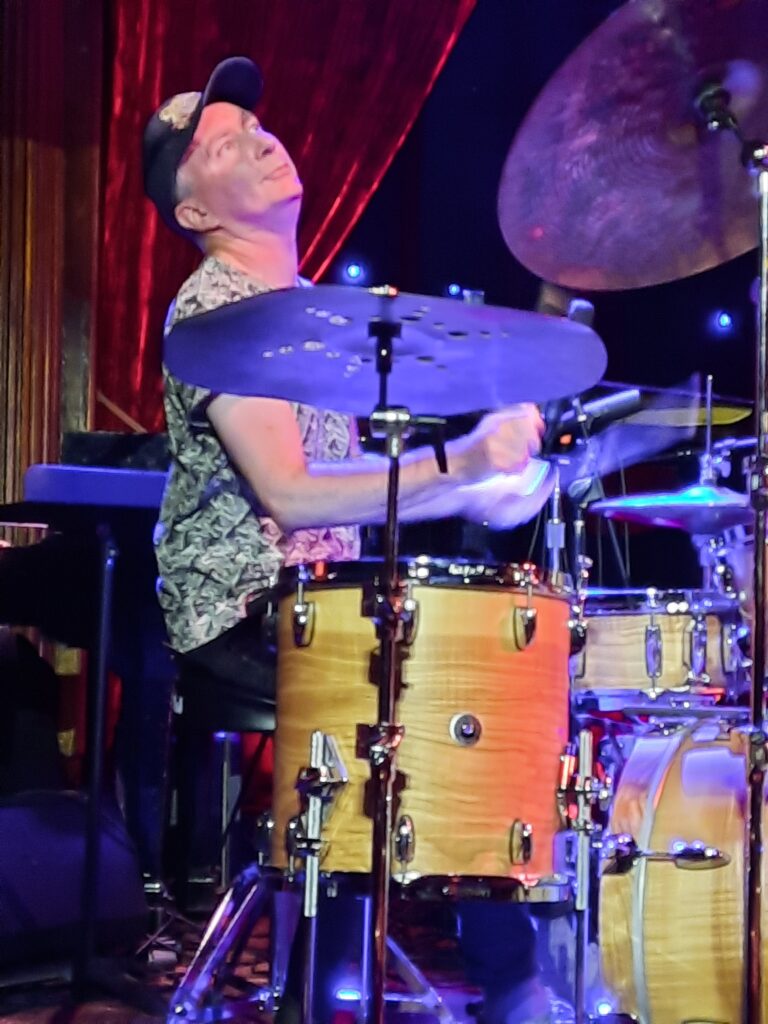
Nate Wood
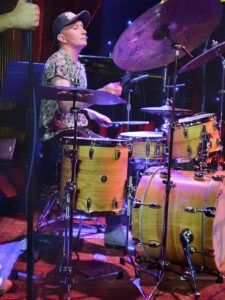 Nate expresses his feelings about Gretsch drums simply, saying, “Gretsch is the sound of drums I hear in my head. The first time I played a Gretsch kit I thought, ‘That’s it.’ They always inspire me to play my best.”
Nate expresses his feelings about Gretsch drums simply, saying, “Gretsch is the sound of drums I hear in my head. The first time I played a Gretsch kit I thought, ‘That’s it.’ They always inspire me to play my best.”
Nate was certainly inspired at Gretsch Night In NYC. He performed with a “house band” that included bass, sax, and keyboards. As soon as they were in place, the group launched into a free-form “out jazz” tune, with Nate exploring sounds between swishing cymbals and staccato attacks on various drums. This eventually broke into an in-time groove, made all the deeper by contrast. Nate’s playing seemed high-energy and effortless at the same time, impressing all the drummers in the audience.
The group’s second tune was more atmospheric, using electronic sounds provided by the sax and keyboards, and non-traditional percussive sounds on the kit provided by Nate. This ultimately built to a rousing conclusion, with Nate blazing both with the band and in solo spots. Predictably, cheers ensued.
MARK GUILIANA
A few years ago, Modern Drummer magazine had this to say about Mark Guiliana: “For many observers, he’s the guy to watch if you want to know where the great art of drumming is right now— and where it could be headed.” And the New York Times recognized Mark as “a drummer around whom a cult of admiration has formed.” High praise, indeed—but indisputably well-deserved.
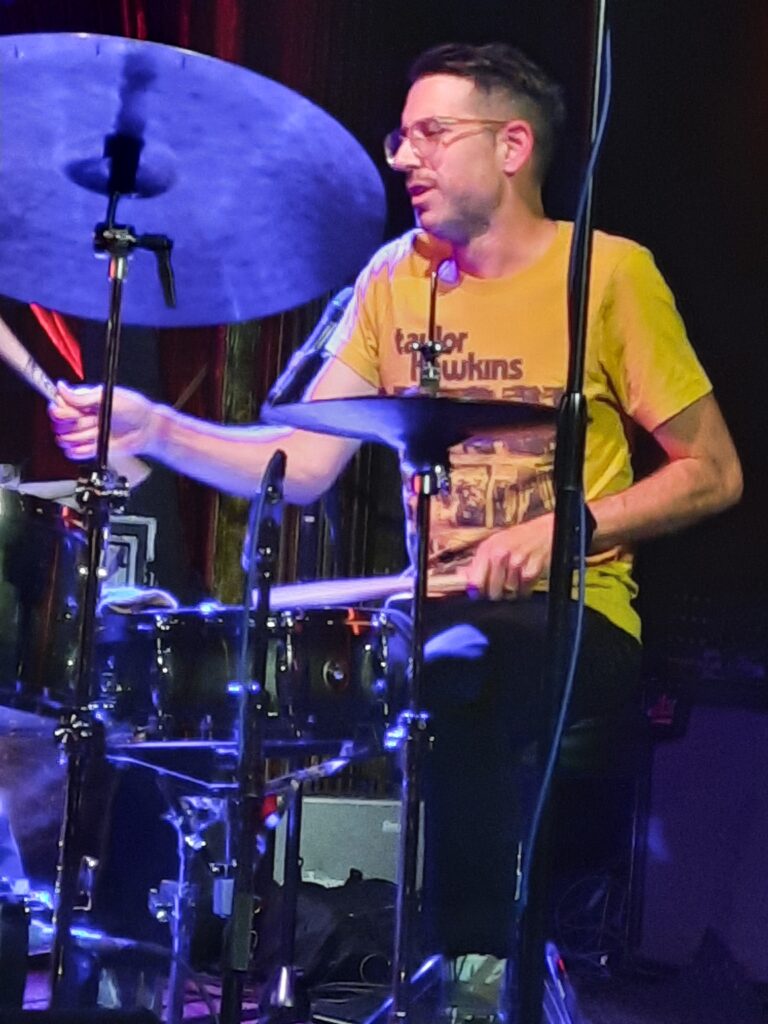
Mark Guiliana
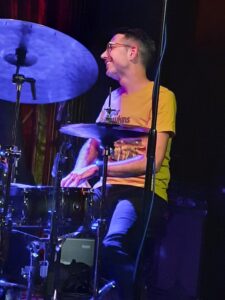 A Gretsch artist since 2011, Mark has earned international acclaim for his innovative and creative style, and has been at the forefront of contemporary jazz for two decades. He has toured extensively around the world, and has created a Grammy-nominated album called Taming the Dragon, with Mehliana, his duo project with jazz icon Brad Mehldau on keyboards and synthesizers. He also played on David Bowie’s single, “Sue (Or In A Season Of Crime)”.
A Gretsch artist since 2011, Mark has earned international acclaim for his innovative and creative style, and has been at the forefront of contemporary jazz for two decades. He has toured extensively around the world, and has created a Grammy-nominated album called Taming the Dragon, with Mehliana, his duo project with jazz icon Brad Mehldau on keyboards and synthesizers. He also played on David Bowie’s single, “Sue (Or In A Season Of Crime)”.
In 2014 Mark was among several Gretsch drummers who accompanied Fred Gretsch on a walking tour of Brooklyn, specifically to view historic sites relating to the Gretsch Company’s operations there. About that tour, Mark relates, “I found Fred Gretsch’s encyclopedic knowledge very impressive and inspiring. I guess by most accounts I’m a jazz drummer, so my heroes are Tony Williams, Elvin Jones, Max Roach, and Art Blakey—all of whom made their names on Gretsch drums. It was cool to tie the research that I’ve done on those drummers to the history that Fred provided—oftentimes from his own first-person experience. It was nice to imagine how, as he described, great drummers would come in to the Gretsch factory all the time—some to get new drums, some to just bounce ideas off each other. That was really cool.”
“Really cool” is a great way to describe Mark’s performance at Gretsch Night In NYC. Following his introduction by Andrew Shreve, Mark entered smiling—acknowledging the enthusiastic welcome he received from the audience. Working with the house band, Mark opened with a low-key, ethereal melodic piece, using timpani mallets on cymbals and a muffled snare drum. This eventually segued into a Latin-infused rhythmic bop feel, giving all of the soloists, including Mark, plenty to work with.
In Mark’s energetic second tune the players occasionally opted for patterns that seemed to depart from the basic structure—yet the band never lost its cohesiveness. Through it all, Mark demonstrated his fluid technique, his always-musical creativity, and his sheer, unbridled enthusiasm for playing Gretsch drums.
WILL CALHOUN
Will Calhoun has been at the forefront of the drumming scene for almost forty years. His Grammy award-winning work with the genre-bending rock band Living Colour alone stands as a monumental achievement. But Will’s resume goes far deeper—and much wider—than that. He’s performed or recorded with a who’s who of music, in as many styles as you care to name. Just a partial list includes Harry Belafonte, Mick Jagger, B.B. King, McCoy Tyner, Marcus Miller, Pharoah Sanders, Wayne Shorter, Ron Carter, Jaco Pastorius, Phillip Glass, Lauryn Hill, Stanley Jordan, Steve Vai, Mike Stern, Ritchie Sambora, Paul Schaffer, and Public Enemy.
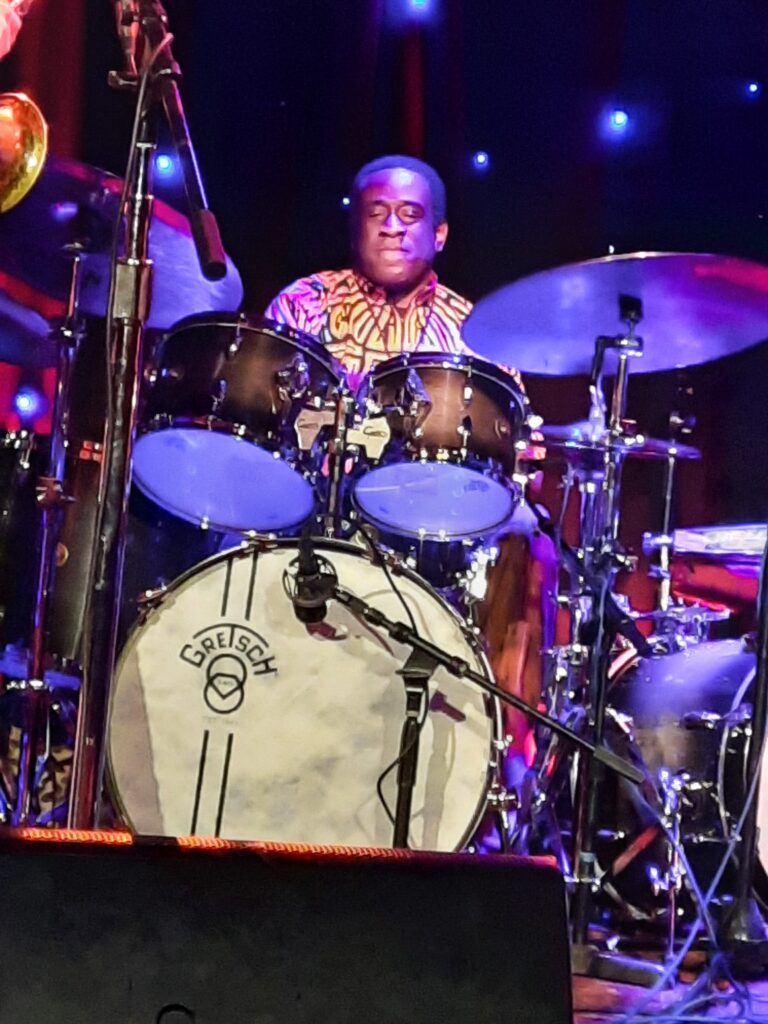
Will Calhoun
Will is a fairly recent Gretsch artist, having come on board in 2020. However, in a conversation prior to his appearance at Gretsch Night In NYC, he described his feelings about Gretsch, saying, “I played Gretsch drums way before becoming a Gretsch artist. I own three Gretsch kits that I purchased over the course of my career, and I’ve used them on many recordings. Actually, I let go of the endorsement game for about five or six years. I began to use Gretsch kits as backline. And, frankly, all the best drummers have them. I loved the drums that I owned, so I finally decided to look into an endorsement.”
When asked about the significance of Gretsch’s 140th anniversary, Will responds, “I’m most impressed by the fact that the Gretsch sound has remained constant through all those years, as evidenced by how many great players have been associated with Gretsch for so long. And the company hasn’t put out bunches of models over all that time. The recipe has remained basically the same, through all the changes in musical trends. Trust me, I didn’t buy my Gretsch kits because I had a couple of extra dollars to spend. The sound of those drums just got into my head. And that’s what’s happened to drummers for all of those 140 years.”
As for appearing at a new Gretsch event sixty-two years after the iconic Gretsch Night At Birdland, Will adds, “I have the famous record that came from that show; my dad purchased it the year it came out. And I found a second copy in a rare-record sale in Japan. So that record has been with me through almost my whole life. The show featured Art Blakey, Elvin Jones, ‘Philly’ Joe Jones, and Charlie Persip. Following that act would be impossible. The best I can do is pay homage to those great drummers on that original show, and to the Gretsch sound. But at the same time, I want to progress with it. So my performance is going to be based on respecting the elders, and looking forward to the future with Gretsch.”
And what a performance it was. Will came on stage with the members of the house band, then opened his set with a powerful and musically imaginative solo on a unique double-bass configuration.
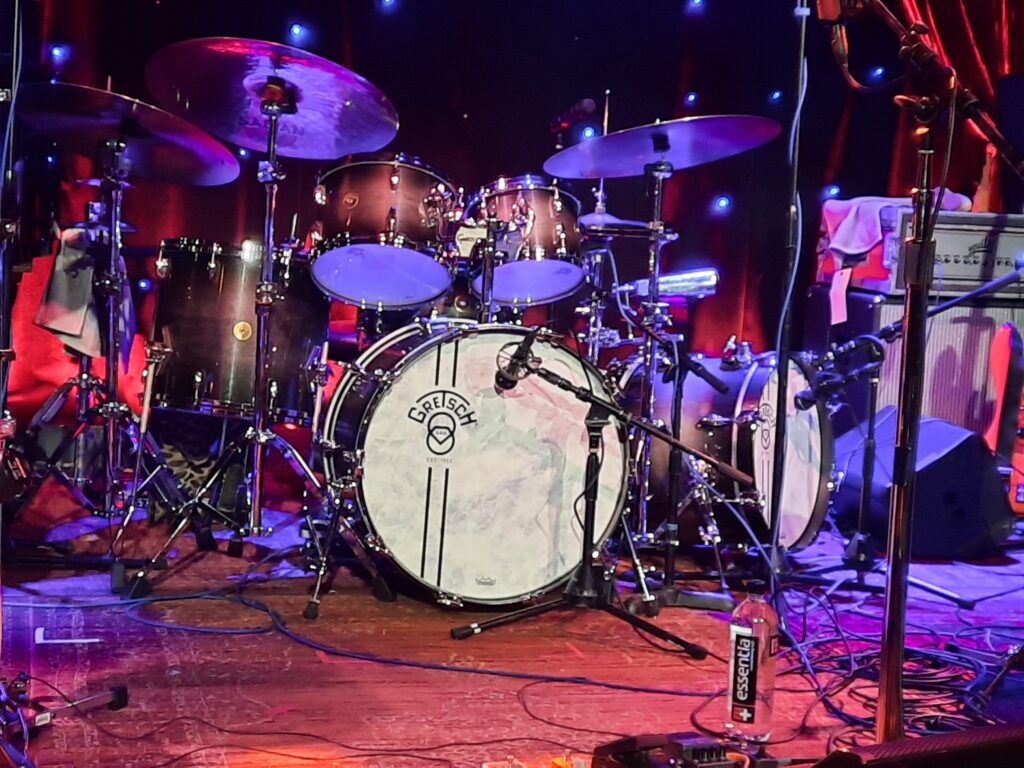
Will’s Unique Setup
Although not known primarily as a jazz drummer, Will gave evidence that he can hold his own in any style as he interacted with the members of the band.
The free-jazz feel of their first tune eventually morphed into a deep 6/8 groove. And the audience collectively smiled when Will opened their second tune with a totally laid-back funk groove.
Of course, things didn’t stay laid back. Will closed out his set with yet another blazing solo that had the audience on their feet when he finished.
AND THEN THE FINALE
Following Will Calhoun’s performance, everyone in the Cutting Room was hoping for more, and they weren’t disappointed. Will returned to the stage, along with Nate Wood and Mark Guiliana, to perform as a drumset trio. In classic fashion, the three drum stars began by grooving together together, then took turns leading the playing—trading licks and grinning from ear to ear. It’s hard to know who was enjoying themselves more: the audience or the drummers on stage.
But all good things must come to an end, and the finale ultimately did so. Will, Nate, and Mark got up and hugged each other, then were joined on stage by Bill Stewart for a well-deserved standing ovation.
Gretsch Night In NYC went into the history books, leaving everyone to wonder what might happen in another sixty-two years!



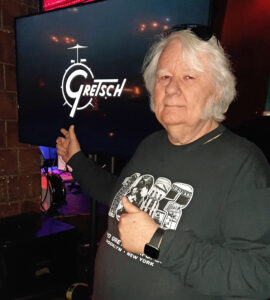
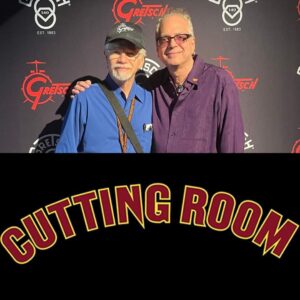
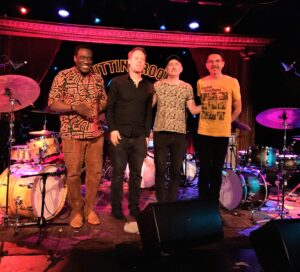
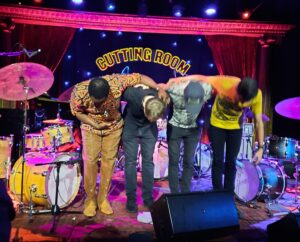
 Previous
Previous